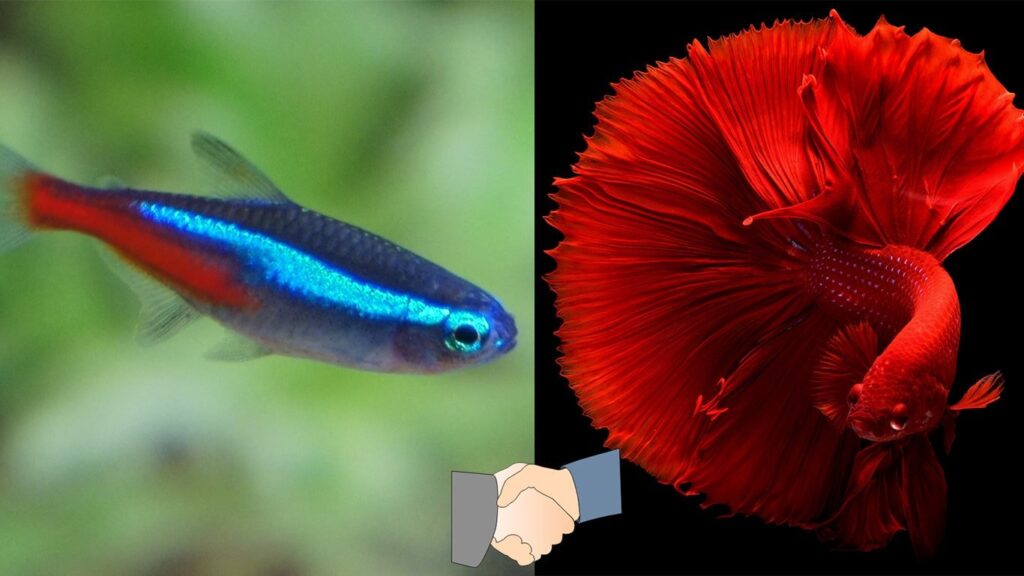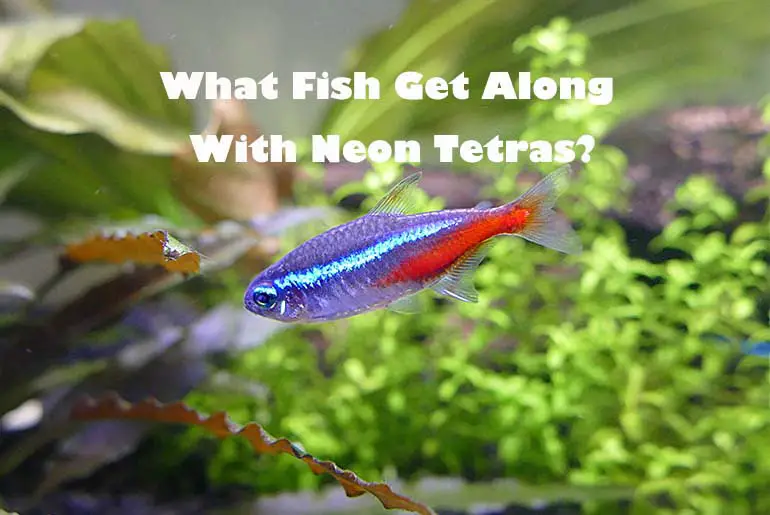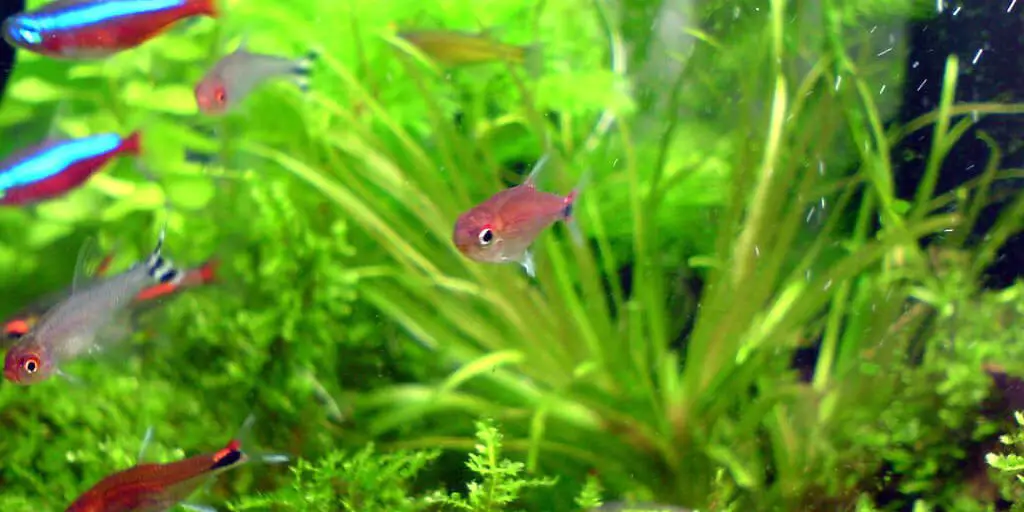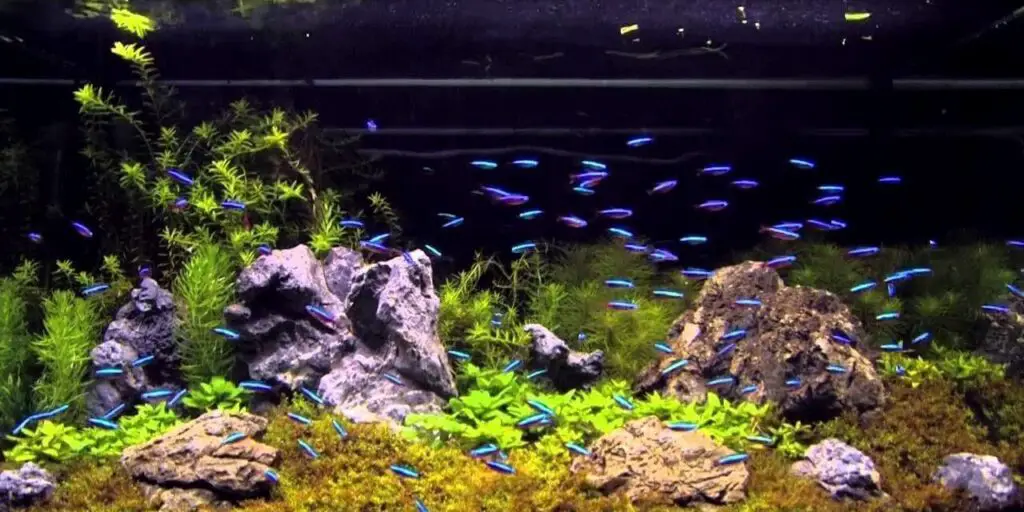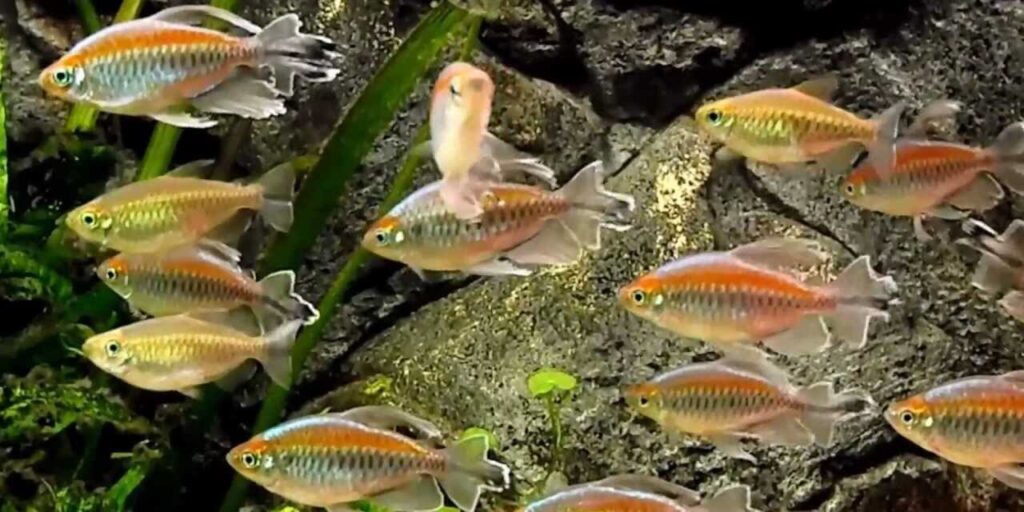Bettas are one of the most popular fish in the aquarium hobby. People prefer this fish for its beautiful colors and flowering fins. Its ability to survive in harsh conditions and small tanks makes it the best option for beginner fishkeepers too. Usually, people keep betta alone in a small tank. But many of us don’t consider that betta can be a great addition to many community tanks. There are various tankmates for betta fish, most of them being small schooling fish with a calm temperament. Today we will be looking at whether neon tetras can be a perfect tankmate for betta or not.
So, can you keep neon tetras and betta together? The answer is yes and it might come as a surprise to most of you. Under some conditions and basic circumstances, bettas can perfectly co-exist with neon tetra. But making the get along is the hard part and many aquarists fail to do so. So, I present you with a guide for keeping neon tetras and betta fish together. I will discuss everything you need to know so that you can immediately plan on keeping these two species together.
Neon Tetra Behavior
Neon Tetras are the fish that will always make it to the top 10 list of most peaceful beginner fishes. Anywhere around the world, experts will recommend beginners to start their fishkeeping journey with these fishes. These fish can make fantastic additions to any community tank. These fish prefer the middle part of the water column and swim in this region mostly. Neon tetras spend most of their time in school and if you keep them alone, they will probably die shortly.
Because of the vibrant colors and energetic behavior, these are quite popular among fish keepers. Larger fish with aggressive behavior and worst tankmates for your neon tetras.
Read More:
Betta Fish Behavior
Bettas are aggressive, territorial, and solitary fish. Especially male which looks more elegant and colorful should be kept alone. Two or more females get along quite well but more than one male will always result in fighting and fin nipping to death. Some times while breeding you can keep males and females together but not for too long.
People usually choose small tanks less than 10 gallons and keep a single betta. Although the results from this are quite impressive, bettas do well in a community tank as well. But if the betta has tankmates with peaceful temperament then it will try to show its dominance. Fin- nipping larger fish should be avoided in a betta tank at any cost. Bettas have labyrinth organ for respiration which means you will find them at the top and middle section of your tank most often.
Can I Keep Neon Tetras And Betta Together?
Looking at their behavior it is clear that these fish are quite opposite. One is peaceful and social whereas the other is aggressive and territorial. So, it is obvious for one to think that you cannot keep them together. But this is not true at all. If certain conditions are met then bettas and neon tetras get along quite well. In fact, neon tetras can be the best community tank partners for bettas. There are quite a lot of things that you must consider before keeping them together.
What Tank Size Do You Need?
The size of the tank is the most important factor to consider. The minimum tank size that I would recommend is 15-gallons. Anything less than that will spike up ammonia quickly. Since bettas live in shallow water and neon tetras prefer swimming horizontally, you should have a long tank rather than a tall one. In smaller tanks, aggression and territorial behavior by betta is quite common.
Water Parameters
It is important to understand that both these fish are tropical and hardy. Every water parameters that these fish thrive in are similar to each other. Bettas are known to survive in the harshest of conditions. But it would be inhumane if you try to copy the natural habitat of betta in your tank. The ideal temperature of the community is 76-82 F. Both of these fish prefer neutral water with a pH of 7.0. But since they are hardy, a little bit of acidity won’t be a big deal. If the pH exceeds 8 then you might witness fading colors and fin rot. Neon tetra and bettas both prefer slightly soft water in the aquarium. So, maintain a hardness of about 2-10 DH.
Your tank should also have lots of hiding spots which can be beneficial for both species. I will talk more about the plants and decors in the later sections.
Steps To Keep Neon Tetra And Betta Together.
Setting up a community tank is not an easy process especially with fish like neon tetras and betta. You must follow some basic steps mandatorily. Here are the steps to keep Neon Tetras and Betta together.
Get Your Tank Ready
As I already mentioned above, a decent tank size has many benefits. A tank of at least 15-gallon capacity is a must to host betta and neon tetras. Place the tank on a strong stand and place it somewhere where it doesn’t get direct sunlight.
You should also have a smaller 5-8 gallon tank ready if things don’t go as planned. Sometimes no matter how hard you try, your betta and tetras won’t get along. In such a case, you must prepare the extra tank for the betta.
The Setup Process
- Since both of these fish are middle and top dwellers the choice of the substrate doesn’t really matter. You can use gravel or sands according to your preference. First, carefully place the substrate at the base of the tank. Be careful because the gravel can break your glass. Spread the substrate evenly using your hand.
- The choice of decors is what decides the quality and wellbeing of this community. You can use plants, driftwoods, and caves for decorations. The main purpose of adding these decors is not decoration but to create hiding spots. Amazon Sword, Anubias nana, Java Fern, and java moss are some of the best live plants for this community. I don’t recommend artificial plants because the pointy edges can affects the fins.
- You can also install driftwoods in the tank. I would recommend hollow driftwoods and caves made with rocks. You can also find commercially available caves for tanks of any size. Be sure that the presence of these decors inside your tank doesn’t obstruct the swimming space for the fishes.
- Install lights that aren’t too bright for your fish. If you have plants then go for heavy lights.
- Choose filters that provide excellent filtration but doesn’t create a huge water flow. Bettas don’t prefer a tank with water movement. A powerhead filter with about 50GPH would be perfect for a 15-gallon tank.
- Finally, add clean tap water.
Cycle The Tank
After the setup process, don’t rush to add fishes because the most important thing is yet to be done. A fishless nitrogen cycle is the most important part of setting up any aquarium. After adding water and equipment leave the tank for about 6 to 8 weeks. Let the filters and lights run so that your tank develops anaerobic bacteria. These bacteria help to convert ammonia into nitrate and nitrates to nitrites. The presence of these bacteria is what makes a tank healthy. Add fish food on a regular basis to speed up the nitrogen cycle. Let the filter and simple biology do the rest of the job for you.
After 6 to 8 weeks, bacteria will build-up in your filter media and water as well. This water will now consist of a high concentration of nitrites and some little ammonia and nitrates as well. This is the right time to add fish to your tank.
Add A School Of Neon Tetras
After 8 to six weeks you can finally add some tetras. It is important to acclimate the tetras before adding them to their new home. So leave the plastic bag containing the tetras to float on the new tank. Since, these tetras are about to live with an aggressive fish, buy at least 8 of them. For a 15 gallon tank, 8 tetras and a betta is a perfect match. After your tetras feel like home, you can finally start thinking about adding bettas.
Finally, Add Betta
After adding the neon tetras, don’t just add up your betta fish. There is a systematic way of doing this.
First, use an aquarium divider to separate territories for betta and tetra fish. Separate about 5-gallon of space for betta and 10-gallon for the tetras. These dividers are easily available in any pet shop. If possible use a glass or other transparent divider so that both the species can see each other. For the first few days, the betta might show some aggressive behavior like restlessness if he spots a tetra. After a few days, the betta will feel more relaxed and calm. This is the right time to remove the divider.
You can also use a breeder box if the divider isn’t available. But I would recommend a divider because a divider will allow your betta to establish his territory. Since betta is a territorial fish, having a territory to its own will make the fish feel more dominant and satisfied.
How Can You Make Neon Tetras and Betta Get Along In An Aquarium?
After adding bettas, there are certain things that you must do to make them get along.
Watch Behavior And Respond Accordingly
After removing the divider, you will face the real challenge. Since there is no certainty that the fishes will get along, you must inspect their behavior carefully. The neon tetras don’t need much attention but the bettas do. Usually, the bettas are the troublemakers. Also, bettas are vulnerable to stress. If your betta shows signs like appetite loss, fin tearing, and constant aggression and chasing then immediately remove it.
For the first few days, you must be very attentive to their behavior.
Choose A Betta From A Community Tank
If your betta was already living with other fish when you bought it then it won’t have a hard time adjusting to the new home. Every living being adapts to the environment that it grows in. So if a betta is raised in a community tank with other fishes then it will be more social. Usually, in petshops people tend to keep bettas in a small space alone, sometimes even smaller than 5 gallons. Only such bettas are aggressive and can’t accept inmates. So be sure to buy your betta from someone who keeps fish not just for money.
Add Tetras First
If you add a betta to the tank then he will establish a territory. A good aggressive male can occupy the whole 15-gallon tank. If you add any other fish to his territory then you won’t be able to stop the brawl that comes next. You can use a tank divider to let the betta establish a territory in a smaller region of the tank.
You must try your best to make the betta think that this is not only his tank. If you allow the betta to occupy the whole tank then there is no way for the tetras to survive. One way to control this is to have tetras in excess numbers. This will make the betta feel small and dominated. This will prevent the betta from attacking any tetra species. Also, the tetras are schooling fish and bettas prefer to live alone so adding tetras in school becomes compulsory.
Try Female Bettas
Females bettas are a lot calmer and social then male bettas. You can add them with any community tank and they will do just fine. The only downside of keeping female bettas is that they don’t have vibrant colors and beautiful fins like their male counterparts. Since female bettas don’t have flowering fins, the chances of fin nipping are also significantly reduced.
Create A Lot Of Hiding Spots
Hiding spots are good for both of these species. Especially the betta gets stressed when he is around schooling fish. So betta finds a safe place and rests in solitude. The tetras’ fries can also benefit from these hiding spots.
You can create these safe places using plants. If the vegetation is dense then bettas can easily adjust themselves between leaves and stems. Other ways to create such hiding spots are driftwoods and stone caves. Some of them are commercially available while you might have to prepare some yourself. If you are using driftwood, I will recommend choosing a thick one and making it hollow using a drilling machine.
Feeding The Community
Bettas are hardcore carnivores and in the wild, their diet consists of larvae and insects. However, neon tetras are omnivores and will accept almost anything that fits in their mouth.
High-quality flake food and pellets can be the best diet option for this community. But sometimes the pellets won’t fit in the tetra’s mouth so crush them or feed flakes directly. Occasional treats for betta include blood worms, brine shrimps, daphnia, and mosquito larvae. If you cant find live food, freeze-dried and frozen meat are great alternatives.
Although neon tetras can feed on the plants and algae in the tank, you need to feed vegetables too. Blanched broccoli and carrots make up a healthy diet for your neon tetras. Remember to remove any uneaten food within 1 hour.
Personal Experience With Keeping Neon Tetras And Betta Fish
Bettas are unpredictable and unique fish. Although we generalize and say that bettas are aggressive, this might not be true with all of them. I have been keeping a community of neon tetras and betta for quite a long time now. When I first introduced a betta to a tetra tank, it couldn’t tolerate the school and became stressed. Eventually, it died. But the next betta that I brought from a friend’s community tank (not a pet-shop) was a social creature.
At first, the betta stayed low and maintained its peace. But now it roams freely all around the tank and there is now brawls for neither food nor territory. The color on my blue crown-tail betta goes perfectly well with the neon tetras. I currently have 8 neon tetras and a male betta in an 18-gallon tank. If any of these fish get sich the I shift them to a hospital tank and treat them in isolation. I also have a separate tank for breeding. With the plants and the dim light my tank now looks like a paradise of fishes living peacefully.
So, based on my personal experience it is fair to say that if one betta doesn’t get along with the tetras then you shouldn’t give up. Maybe another betta of another kind might get along. Since bettas are found in every pet shop at a relatively low price, you can try new betta every time you fail. Repeat this until you get success.
Neon Tetra Buying Guide
While buying neon tetras make sure that you are getting the healthiest ones from the pack. Be sure that you are bringing color and joy to your tank, not diseases and parasites. In petshops, tetras are kept in huge community tanks with lots of other species. So, there is a high chance that you might introduce an infected neon tetra in your tank. Look out for these things while choosing a neon tetra:
- Choose active tetras that are swimming around the tank. If a tetra is hiding and avoiding other fish then avoid purchasing it.
- Look out for bright colors and neat fins.
- If the tank contains any dead fish then avoid all fish from that tank.
Betta Fish Buying Guide
Usually, betta fish are kept alone and they don’t carry infections with them. But it is important to check on them before making a purchase.
- Choose a betta from a community tank rather than a solo tank.
- In the betta, look for deep vibrant colors, big flowing fins, and only buy if it is swimming with ease.
- If the fish stays in a corner and can’t swim horizontally then better avoid it.
Can I Keep Neon Tetras And Betta In A 10-gallon Tank?
The bare minimum tank size for a school of 6-8 tetras only is 10 gallons. Whereas a single betta can easily survive in a five-gallon tank. But when you put these two species together i.e. 6-8 neon tetras and betta, the minimum tank size becomes 15 gallons. many might say that the minimum tank size is 20 gallons but from my personal experience, 15 gallons would do just fine.
A 15-gallon tank allows the betta to establish a small territory without having to show aggressive behavior towards the tetras. Anything less than 15 gallons will be overcrowded and surely result in aggression. In some rare cases, you might see success in a 10-gallon tank if you reduce the school size to 4 with a female betta.
Read More: How Many Neon Tetras in a 10-gallon tank
Conclusion
All in all, bettas can be really good tank mates for your neon tetras if you know how to make them get along. For a beginner fishkeeper, it might not be the best option to keep betta and tetras together. But if you have a little experience with either of the species then you are good to go.
I think I have included everything related to keeping neon tetras and betta fish. After reading this you should be able to keep them together in a 15-gallon tank. Any feedback or recommendations will be heartily welcomed in the comment sections below.
Reference
Image Credit:
- https://en.wikipedia.org/wiki/en:Creative_Commons
- https://creativecommons.org/licenses/by-sa/3.0/deed.en
